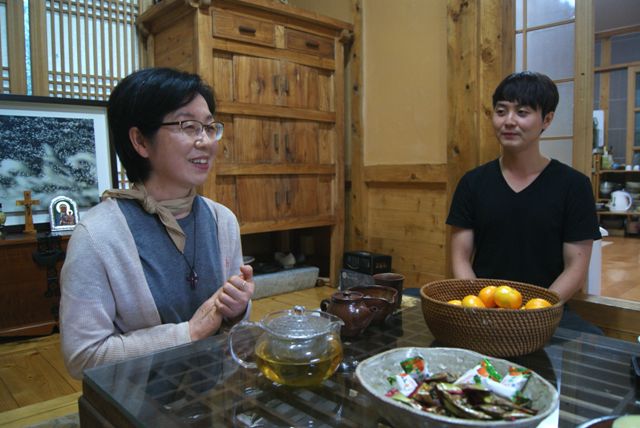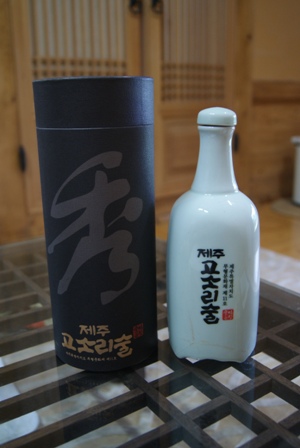| |
 |
|
| ▲ Kim Hee-Sook (left) brews using a traditional gosori with her son in a three-generation deep tradition. Photos by Darren Southcott |
‘Blue or white?’
It is the question every galbi lover yearns.
Nothing quite washes down pork and soy bean paste like the sharp burning sensation of soju, the cheap, industrialized intoxicant reportedly the world’s most popular liquor.
Only a shot glass of this mid-strength spirit can truly complement Jeju three-layered pork after it has been grilled, dipped in “doenjang” sauce and wrapped in a crisp lettuce leaf.
Despite it doing the job (intoxication) well, however, soju seems much more a product of today’s fast-paced, high-stakes society than the land of the horsehair-hatted, pipe-smoking yangban literati of yesteryear.
More likely to raise his glass with a thrust and cry “one shot” than to delicately savor the liquor’s bouquet under his nose, connoisseurs soju drinkers are not.
This is not to say Korea is without a long tradition of brewing, and Jeju even has its own distinct heritage.
Although very nearly lost in the rush to development, it lives on — just — under the stewardship of one family in Seongeup Folk Village.
The family’s commitment to tradition is evident in their choice of home, a traditional “doljip” stone cottage with low, thick timber eaves and a bristling thatched roof straight out of Hobbiton.
The sturdy structure not only houses the family, but also the distillery which produces Jeju “gosorisul,” a local variant on traditional soju.
While most other sojus are made with rice, gosorisul is made with local millet and Kim Hee-sook strictly follows tradition in making the beverage over three months.
“No one else makes true gosorisul because it takes too long to ferment. Other gosorisul makers use rice rather than millet, so it is not traditional. Even Andong soju uses a modernized distillation process for mass production,” she says.
Jeju is historically one of three regions famed for its soju production in addition to Gaeseong (now in North Korea) and Andong, Gyeongsangbuk-do Province.
Kublai Khan, Genghis’ grandson, is credited with introducing soju’s antecedent to the peninsula during the Yuan Dynasty (1270-1356), and it is no coincidence that all three regions were significant Mongol power bases.
The drink had traveled the Silk Road from the Middle East, and its origin is apparent in the North Korean term for it, “arakju,” which retains the Arabic root “araq” meaning distilled liquor.
Seven centuries after the Mongols, Kim slowly learned the tradition from her mother-in-law, Kim Euljeong, after marrying 35 years ago.
Kim Euljeong is the only surviving intangible cultural asset holder and is an expert in not only gosorisul but also omegisul. The latter is also millet-based and equivalent to makgeolli, or rice wine.
“Although we only use grains, we are able to create an aromatic drink that smells of fruits and flowers,” she says.
“It is also good for your health and for your blood system — much more so than the cheap alcohols that are produced today — and it is perfect as a ‘banju’ [table wine].”
| |
 |
|
▲ Stronger than mass-produced soju, gosorisul
was once used for traditional rites and family events. Photo by Darren Southcott |
She then pours me a glass. I take it in both hands, turn my head as per tradition, and gently sip. Rather than the familiar sharp burn of cheap soju, the liquor is fresh and deep, warming the upper body like a vintage whiskey.
At 40 percent alcohol by volume, it is also strong, and my head lightens as Kim leads me under more timber beams to a padlocked door. She opens it to reveal a low-ceilinged room full of huddled ceramic pots resembling plump, smoking hourglasses.
These original earthenware stills — “sojutgori” in standard Korean, “gosori” in Jeju language — give the drink its name, and authenticity.
“Our alcohol is genuine and is distilled using real gosori; they are truly irreplaceable.”
Following the traditional method means low-profit margins, long hours and low-scale production — gosorisul is certainly not a money spinner, despite its niche market.
To ease the pressures, and seeking to keep it in the family, her 28-year-old son Kang Han-saem came on board as her apprentice. Although he was at first unsure if it was for him, he has since embraced his destiny — and the weight upon his shoulders.
“I am proud of what I am doing now,” he says, “especially as I can follow in the footsteps of my grandmother and mother.”
Although surely in able hands, it was once unthinkable that this tradition of nearly 800 years would be entrusted with just one stoic family.
Getting drunk has always been popular in Korea, and a century ago almost every Jeju family had its own brewing equipment for cooking up a variety of local tipples.
It was one of the few ways to make a living, says Kim, and the more refined gosorisul was used for religious rituals and life events.
This began to change after the Japanese invaded in 1910. Noticing the locals’ love for a tipple, they enacted the Liquor Tax Act in 1916 to boost state coffers.
Production was standardized — Korean-style stills and yeast were replaced with Japanese variants — and only authorized at state-sanctioned breweries.
“It was inevitable after that that Koreans would stop making alcohol at home,” says Kim.
The mortal blows were then self-inflicted.
After liberation in 1945, the 1965 Grain Management Law prohibited the use of grains (including rice and millet) in alcohol production. These were replaced with sweet potatoes, molasses, tapioca, and other foodstuffs.
Despite the restrictions, many regional varieties remained until 1973, when production was restricted to one state-sanctioned distiller per province. This faux national diversity lives on today, with “Hallasan” Jeju’s monopolistic brand.
It is in true underdog spirit, then, that this Seongeup family is the keeper of a flame still burning after surviving the threats of colonization and authoritarianism.
Against the odds, Kim sees a bright future for gosorisul, a potent chapter in Jeju’s history.
“I am honored to inherit this tradition, and so is my son.”
You can buy some homemade gosorisul yourself from Kim Hee-sook and family at Seongup Folk Village.
Call 064-787-5046/010-86643276 or visit 4726 Jungsangandong-ro, Seongeup-ri, Pyoseon-myeon, Seogwipo-si
|





















